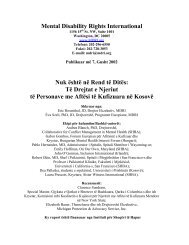Torture not Treatment - Disability Rights International
Torture not Treatment - Disability Rights International
Torture not Treatment - Disability Rights International
Create successful ePaper yourself
Turn your PDF publications into a flip-book with our unique Google optimized e-Paper software.
TORTURE NOT TREATMENT<br />
The main legal difference relates to whether pain is inflicted for a purpose listed in article<br />
1(1). 130 This prong of the definition is described in section 4 below. For many years,<br />
international authorities have failed to examine whether practices by medical authorities were<br />
perpetrating torture simply because the stated purpose of the act was for the purpose of<br />
―treatment.‖ With the adoption of the new UN Convention on the <strong>Rights</strong> of Persons with<br />
Disabilities (UN CRPD) and the Report of UN Special Rapporteur on <strong>Disability</strong> and <strong>Torture</strong>, it is<br />
now possible to examine medical practices more closely to determine whether they meet the<br />
standard of ill-treatment or torture.<br />
The following four elements are required by the UN Convention against <strong>Torture</strong> to determine<br />
that an act is torture. Only the first and last elements are needed to show that a practice<br />
constitutes ill-treatment.<br />
Pain is severe<br />
The prohibition against torture under international human rights law applies only to pain and<br />
suffering that is ―severe.‖ Such pain can be physical or mental. In analyzing whether a practice<br />
of inflicting pain rises to the level of severity that would constitute torture, human rights bodies<br />
will consider all ―the circumstances of the case, including the existence of a disability.‖ 131 The<br />
subjective experience of the victim is critical to understanding what pain might cause the<br />
emotional terror and physical suffering that rise to the level of torture. The powerlessness and<br />
vulnerability of children or adolescents with mental disabilities, held in detention, and subject to<br />
treatment against their will are all factors that contribute to suffering. As UN Special Rapporteur<br />
on <strong>Torture</strong>, Manfred Nowak, has explained:<br />
All purposes listed in Article 1 CAT (Convention against <strong>Torture</strong>)…refer to a situation<br />
where the victim of torture is a detainee or a person “at least under the factual power or<br />
control of the person inflicting the pain or suffering,” and where the perpetrator uses this<br />
unequal and powerful situation to achieve a certain effect, such as extraction of<br />
information, intimidation, or punishment. 132<br />
In the law enforcement context, the UN Committee Against <strong>Torture</strong> (CAT) has taken a strong<br />
stand against ―the use of electric shock devices to restrain persons in custody‖ and<br />
―recommended that they be eliminated as inevitably leading to breaches‖ of the Convention. 133<br />
The UN Special Rapporteur has taken a similarly strong stand against ―the prolonged use of<br />
restraints, which may amount to torture or ill-treatment.” 134 The isolation of the individual and<br />
prohibition of human contact are also factors that have been found to cause ―persistent and<br />
unjustified suffering which amounts to torture.‖ 135<br />
The UN Special Rapporteur has recommended that any use of electric shock be prohibited ―to<br />
restrain persons in custody‖ as such practices may ―inevitably‖ devolve into ill-treatment along<br />
with other practices, even if a low level electric shock does <strong>not</strong> violate the UN Convention<br />
23




